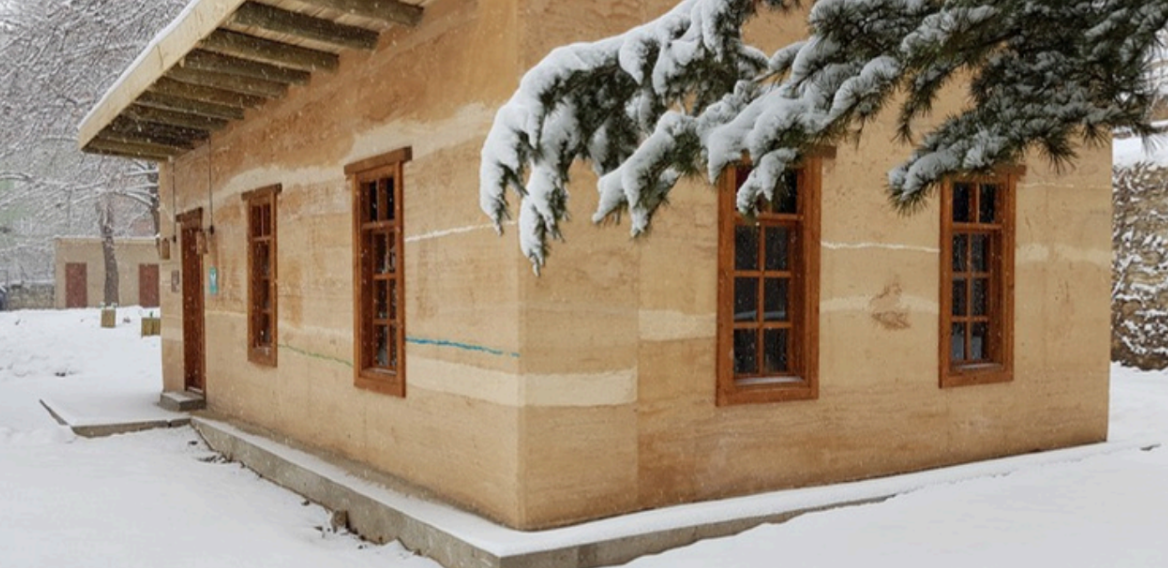
Sector: Architecture | Circular Design, Natural Materials, Sustainable Building Production, Community Development
The Anatolian Angel Education and Production Center is a sustainable architectural and community model developed in Keban using entirely local earth and circular materials. The building previously served as a gathering and production space for women, and today continues to host community activities such as weddings and music workshops.
During the project:
Local earth was used for wall construction.
Old wooden telephone poles were repurposed as beams and structural elements.
Factory pallet waste was transformed into seating and furniture.
Local baskets and wooden objects were converted into lighting fixtures.
A natural insulation and green roof system was created using a mix of tree bark + perlite + soil.
Harvested rainwater stored in a tank was used in toilet reservoirs.
Accessories contributed by local women were incorporated to strengthen the cultural identity of the space.
The project integrates natural building techniques with circular materials, creating a place-based, culturally rooted and sustainable design model.
Target Groups:
Women
Local producers and artisans
Youth (including future planned art/design workshops)
Beneficiaries:
Local community
Women entrepreneurs
Rural production ecosystem
Regional cultural heritage and material know-how
Impact and Outcomes
Environmental and Circular Economy Impact
Material waste was minimized through reuse and upcycling.
Earth walls provided natural fire resistance, increasing building safety.
The green roof and natural materials improved thermal performance and reduced energy demand.
Rainwater harvesting reduced fresh water consumption.
The building serves as a low-carbon, climate-positive model for the region.
Community and Social Impact
Women’s participation in production and spatial design processes was strengthened.
During the 2020 Elazığ earthquake, the building functioned as a safe gathering area due to its structural resilience.
The space contributed to social continuity and community identity.
Cultural and Architectural Impact
Traditional earth construction was reinterpreted through modern sustainability principles.
Cultural artifacts incorporated into the space strengthened local identity.
Transferability & Scalability
1. Circular material approach is easily replicable
Upcycling structural and interior elements (telephone poles, pallets, baskets) can be adapted with locally available waste materials in any region.
2. Natural building materials can be applied across Anatolia
Earth, wood, perlite, tree bark and other natural materials are widely accessible in Türkiye, making this model highly scalable.
3. Replicable for community centers, municipalities and women’s cooperatives
The model can serve as a production hub, cultural venue, youth workshop space or women entrepreneurship center.
4. Culture–design–local material integration is scalable across sectors
The approach is applicable to architecture, design, art, rural development, sustainable tourism and local gastronomy.
Offering regional dishes within a culturally significant earth building can create a sustainable business model for women entrepreneurs.
5. “Modernizing earth” is a relevant model for climate-positive architecture
The fire resistance and low-carbon profile of earth structures make this technique highly relevant for future sustainable projects.
The Anatolian Angel model combines natural materials, circular economy, local culture and community engagement, offering a strong example for rural transformation. Although currently used in a limited capacity, it holds significant potential for future culture-art–gastronomy–natural material workshops. It is a transferable best practice for women’s entrepreneurship, green transition and community resilience.
Contact Person: Özgül Öztürk
Email: [email protected] | [email protected]
Website: https://donguseltasarim.com/
